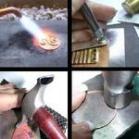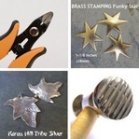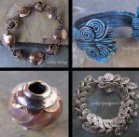Hammering Metals
by Yelena
(South Portland, Maine)
I happened upon your free "how to make hoop earrings" guide. I think I got a little too ambitious when I saw how easy it is to hammer copper wire because I ran into my kitchen, grabbed a hammer and a flat metal cooking instrument and started hammering away. Unfortunately, I didn't get far. I wasn't able to hammer my 20 gauge copper wire at all. I was wondering if it is because I don't have one of those steel bases you have in your pictures? Or was I not doing it hard enough? It says "gently" in your guide, but what is gentle when it comes to metals? Please help a fellow jewelry fanatic.
Stacy's Answer:
Yelena, your main difficulty is probably that you are not using the proper tools to hammer your wire. You do need a steel bench block to best hammer, flatten or texturize your wire and other soft metals. The investment is well worthwhile and will also save your pots! :) I prefer a ball pein hammer, although a planishing or chasing hammer will work also. I use a 4 oz. ball pein hammer with a 2-1/2 inch head size because I've found the smaller head is easier to control (less finger mashing.)As to how hard to strike the wire, well...you have to practice that a bit. You need to hit it hard enough to start to flatten the metal but not so hard that you damage your tools or yourself or the wire! The good news is that copper is inexpensive and great to learn on. Mistakes can be pitched right in the trash or recycle bin. You don't need to lift the hammer very high when flattening wire. The motion is sort of a strike and slide. You can actually "pull" or "push" the metal with your hammer in the direction you wish it to flow. I use gentle taps in a straight up-and-down movement to blend in the more hammered area with the non-hammered part of the wire.
To clarify the tutorial a bit, you can "harden" soft wire by tapping it with a rawhide or plastic hammer on your steel bench block or by slapping it, using some force with a good ole fashioned rubber spatula and a wooden cutting board. This actually causes a molecular change in the metal which is called "work hardening." The plastic or rawhide hammers and the rubber spatula do not mar the metal or flatten it....they only harden the wire. After I've gotten a nice round shape to my hoops, I harden them slightly with a plastic hammer so the metal "remembers" the shape before I flatten part of them. (You can also harden into shape by very gently tapping the wire with your ball pein hammer in a straight up-and-down motion, taking care not to flatten it.)
I find that I get the best results for those hoops using 18 gauge dead-soft wire, but 20 gauge will work also. Just remember that you must be more careful with the thinner 20 gauge wire. Be sure to put a pot holder or small towel, sand bag etc. under the steel block to help keep it in place and reduce the hammering noise.
Comments for Hammering Metals
|
||
|
||
















